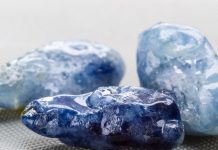
Are zircon and zirconia the same? Despite similar-sounding names, zircon, zirconium, and cubic zirconia refer respectively to a mineral, an element and a synthetic material.
Zircon is the mineral zirconium silicate (ZrSiO4), which contains the elements zirconium, silicon, and oxygen. It crystallizes in the tetragonal system and has a very substantial Mohs hardness of 7.5. With its durability, high index of refraction, and range of pleasing colors, zircon is an attractive gemstone; the colorless variety was once a popular—and sometimes fraudulent—substitute for diamond.
What is Zircon?

As the most common zirconium-bearing mineral, zircon is widely distributed in igneous and metamorphic rocks. Its extremely durable crystals can survive for billions of years. Because zircon often contains traces of uranium, it is an ideal medium for the radiometric dating of ancient rocks. The oldest known rocks—more than four billion years old—have been radiometrically dated by measuring the extent of the atomic decay of the uranium in tiny zircon crystals.
Zircon serves as a refractory material in ceramic, foundry, and casting applications. It is also the only ore of zirconium, a soft, ductile, silvery-white, relatively common metal that ranks 20th in crustal abundance.
German chemist Martin Klaproth discovered the element zirconium in 1789. A century later, metallurgists learned that it improved the corrosion resistance of steel.
Because it does not absorb neutrons, zirconium is the preferred cladding metal for fuel rods in nuclear power plants. And because powdered zirconium reacts quickly with oxygen, hydrogen, and nitrogen, it is used to purge traces of gases from vacuum tubes.
What is Zirconia?

The second most common zirconium-bearing mineral, after zircon, is baddeleyite, or zirconium oxide (ZrO2). Baddeleyite, also known by the industrial term “zirconia,” crystallizes in the monoclinic system. Synthetic zirconia, prepared by roasting zircon at high temperatures, was the mantle material in the first incandescent lamps of the 1880s. By 1900, Nernst-type electric lamps contained zirconia “glower rods” which, when heated electrically, glowed with a brilliant, white incandescence.
With its high reflectivity, zirconia is used as an opacifier and a pigment in ceramic glazes. Zirconia is also employed in the oxygen sensors that control combustion in gas furnaces and automotive engines.
About 600,000 tons of zirconium (contained in zircon concentrates) are now recovered annually as a by-product of mining titanium-rich sands.
Uses for Synthetic Zirconia
Just as zircon is a gemstone, zirconia (synthetic) also has a gem use. In the late 1960s, researchers working with advanced optical-electronic materials for lasers and computer-chip substrates became interested in zirconia. They found that when monoclinic zirconia is heated nearly to its melting point of 2690° C. (4874° F.), it passes first through a tetragonal phase and then a cubic phase.

But the cubic phase was unstable and reverted back to its monoclinic form upon cooling. Adding traces of yttrium oxide (yttria), however, stabilized the zirconia in its cubic phase. Known as yttria-stabilized zirconia, or YSZ, this hard, chemically inert, polycrystalline, ceramic material now has many specialized uses in medicine and industry.
Single YSZ crystals, grown in special high-temperature crucibles, are called “cubic zirconia” or “CZ.” It was first commercially synthesized in 1976. Today, 13 tons of CZ are manufactured each year.
So despite the sometimes confusing similarity of their names, zircon, zirconium, and cubic zirconia have distinctly different properties and fascinating uses.
This story about are zircon and zirconia the same appeared in Rock & Gem magazine. Click here to subscribe. Story by Steve Voynick.













